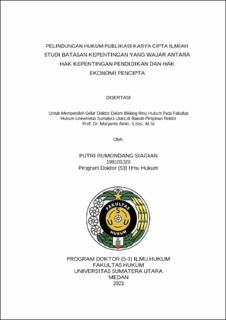| dc.description.abstract | Legal protection for the publication of scientific copyright works has become increasingly crucial with advancements in education and innovation. The educational purpose is a prerequisite for allowing the use of protected works without the consent of copyright holders, as long as moral rights are acknowledged, as stipulated in Article 44 of Law No. 28 of 2014 on Copyright. The absence of limitations on educational purposes as part of permissible copyright infringement poses a challenge in striking a balance between educational interests and the economic rights of creators of scientific copyright works. Potential conflicts arise as the urgent need to expand access to education and research often clashes with the economic rights of creators to control and benefit from scientific copyright works.
This research, of a normative juridical nature, utilizes secondary data by processing information from primary legal sources, secondary legal materials, and tertiary legal materials. Data collection techniques involve document studies, supplemented with qualitative analysis.
Based on the research findings, it is evident that limitations on educational purposes consider the objectives and nature of use, whether it is commercial or non-commercial. The nature of the copyrighted work used, whether factual, scientific, or creative, is also taken into account. The quantity and substance of the portions used concerning the entire original work are considered, as well as the impact of use on the market value or potential market of the original work. The study also provides an understanding of educational or research institutions utilizing fair use for educational purposes. The amendment of the Copyright Law accommodating guidelines for educational purposes is essential to achieve a balance between educational objectives and the economic rights of creators of scientific copyright works. The government is challenged to accommodate all publications related to educational purposes, distribute and disseminate scientific copyright works to educational institutions, and oversee these actions through an education copyright board. Thus, the foundation supporting the notion that the use of scientific copyright works for educational purposes is fair use will not undermine the economic rights of creators. | en_US |


